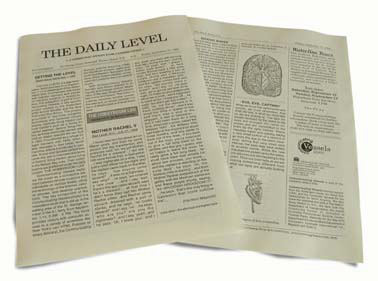

EXCERPTS FROM THE DAILY LEVEL # 11
Friday, September 11, 1998
MOTHER RACHEL V
Sea Level, N.C., July 27, 1998
....I never saw him for about ten or fifteen years, and then he came aboard this big supertanker, and everyone said, 'oh, we got Mother Rachel for a steward'...I did see him once before that, in Galveston ...I was nightmate on a ship, I was just a relief officer for the night, and the captain came back on the ship, he says,....'has anyone come aboard?' ...it was on a Saturday...I say, 'why?' ...he says, 'we ordered a new crew' ....and I say 'well, there's this guy came aboard, says he's a steward'... at that time I didn't know they call him Mother Rachel either...and Rachel came aboard, dressed with a pair of slacks, and he says, 'no cooks aboard?', and I say, 'no'... he says, 'who are you? are you the nightmate?', and I say, 'yeah', and he says, 'oh, I know you'...and I say, 'yeah, you were with me long time ago, during the war', and he says, 'oh yeah, well, I guess I better cook dinner'.... so, here comes Rachel back a little while later, and he's wearing a pair of purple shorts and a Mexican sombrero and a Hawaiian shirt... and the captain comes back and he says, 'did anyone come aboard?', and I say, 'no'...he says, 'well, we're gonna sail later on tonight, I'll make up your wages until about ten o'clock...we're supposed to leave at ten, I'll pay you off'....he says, 'we didn't get any cooks?'...I said, 'no, but the steward is in there, cooking dinner'...and it was about four thirty or quarter to five and there was a ship in the shipyard...it was in Galveston.... and it had been there for a long time, it had lost a screw, called 'the Midway Hills'...the Midway Hills had been in the shipyard for about three months, and she starts to back out of the dock...if you back out of the dock, you're supposed to give a full long blast on the whistle, and this guy, I guess, was so happy to leave the dock, he really gave a full long blast....he must have blew that whistle for about two minutes, you know.... and the captain is standing on the poop deck 1), he says, 'oh, the Midway Hills is leaving'...and then Mother Rachel stepped out of the galley with his Mexican sombrero and these purple shorts, saying, 'Ah-WHOOOH-HOOOOOH!!!!!' ....he says, 'that's the only thing in Galveston that could outblow me'....
(Harrison Maycroft)
1)poop deck = the aftermost and highest deck
MAKING WAVES
There are many ways of transmitting forms of energy. One of the most important of these is by wave motion. Energy can be carried on many kinds of waves: water waves, sound waves and electromagnetic waves. Sound is a form of energy that is produced by a vibrating object. Not only vibrating solids produce sound. In a whistle, a column of air vibrates; this vibrating air is the source of the sound. You can hear the vibrations, because the air conducts the vibrations to your ear. Air serves as a medium, but gases are not the only mediums that will conduct sound. Liquids are even better mediums. The next time you go swimming, find two stones. Put your head under the water and bang the stones together. You will be surprised at how loud a sound the stones make. Ask a friend to stand in the water about 150 feet from you. Let him/her bang the stones together in the air. Listen to the sound it makes. Then, after you have ducked your head beneath the surface, have your friend bang the stones together in the water. The underwater bang will be much louder, proving that sound travels through water more rapidly and with less energy loss than through the air.
FATHOMING
Depth is determined by measuring the round-trip time for a pulse of ultrasonic energy to travel from the boat to the bottom of the water and be reflected back to the point of origin. The frequency of the audio pulses generally lies between 50,000 and 200,000 cycles per second, too high to be heard by human ears. The major components of a depth sounder are a source of energy (transmitter), a means of sending out the pulses and picking up the echoes (transducer), a receiver to amplify the weak echoes, and a visual presentation of the information. The visual presentation of information on the depth of the water is accomplished by an indicator, a recorder, or a video display.
'EYE, EYE, CAPTAIN!'

While we know that light travels very quickly, we must remember, that what we see, is what our mind tells us we are looking at. The light impulses received by the retina in the eyes are changed into nerve impulses and are transmitted to the brain by the optic nerves. These impulses travel very quickly, taking a very small portion of a second to go from the eye to the brain. However, during that very small time interval, the eyes may have shifted to another scene. While the new impulses are picked up by the retina, the old ones are still travelling to the brain. Thus our brain tells us we are seeing something different from what our eyes are actually looking at.